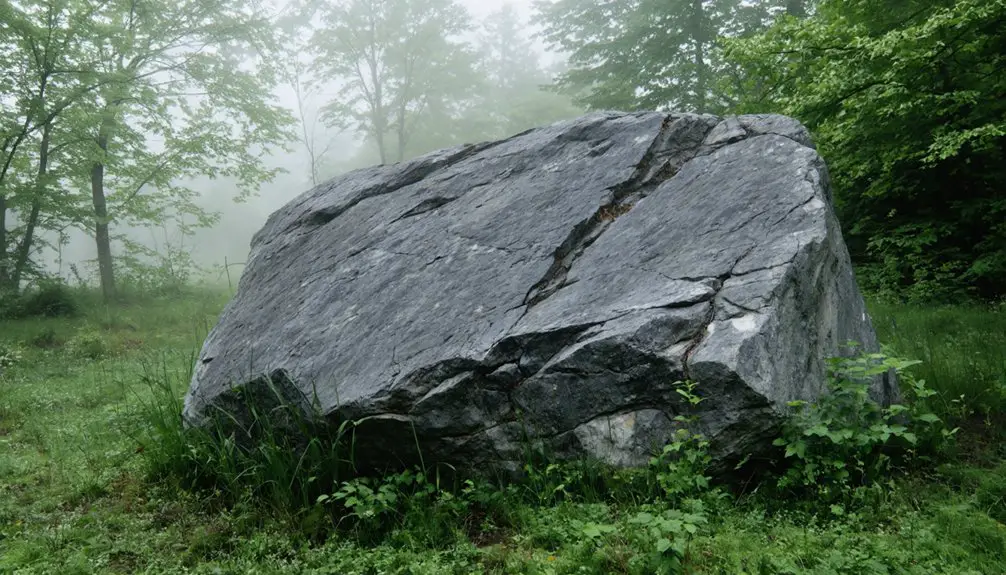You’ll discover Big Rock’s remnants along M-32, where a massive glacial boulder inspired settlers to establish this frontier community in 1882. The town flourished with Seth Gillet’s post office, William Remington’s general store, and a population that peaked at 100 residents by 1910. After the post office closed in 1920 and the general store burned in 1966, Big Rock faded into history. The sacred boulder, known as Kitcheossening, still guards intriguing secrets beneath its surface.
Key Takeaways
- Big Rock was a frontier settlement in Michigan named after a prominent glacial boulder, which served as a sacred site for Native Americans.
- The town reached its peak around 1910 with approximately 100 residents, supported by lumber industry jobs and essential businesses.
- Major community features included a Congregational church, general store, sawmill, blacksmith shop, and post office established in 1882.
- The post office’s closure in 1920 marked the beginning of Big Rock’s decline into a ghost town.
- After the general store’s destruction in 1966, only remnants remained of what was once a thriving frontier community.
The Story Behind the Town’s Name

When early settlers encountered the distinctive boulder protruding from the ground along what’s now M-32 between Gaylord and Atlanta, they found the perfect namesake for their budding community.
The rock symbolism became central to the town’s identity when Seth Gillet established the post office in 1882, officially marking Big Rock on the map.
You’ll find that naming significance often stemmed from natural landmarks in Michigan’s frontier settlements, and this partially buried boulder proved no exception. The community grew to include a general store when William Remington opened his business in 1902.
While the true size remains unknown, with much of it hidden underground like an iceberg, its visible presence was enough to inspire the hamlet’s name.
Today, even though the town has vanished, you can still spot this enduring landmark that gave Big Rock its distinctive identity. The site remains a testament to the area’s former lumbering industry.
Pioneer Settlers and Early Development
After Seth Gillett established Big Rock’s first post office in 1882, the settlement quickly grew into a bustling frontier community centered around logging operations.
Despite pioneer hardships, you’ll find that early settlers built a thriving town at the crossroads of M-32 and Thornton Road. The community’s resilience showed in their rapid development of essential services – William Remington’s general store served as both merchant hub and post office by 1902, while a sawmill provided vital employment. Much like the ill-fated Port Sheldon Land Company, the town’s early investors poured resources into ambitious development projects. As in Phoenix, the town featured a blacksmith shop that served the community’s needs.
You would’ve seen the town’s close-knit spirit in its church, school, and grange hall, where farmers gathered for support and social events. A local blacksmith kept equipment running for both agricultural and logging operations, demonstrating how these hardy pioneers created a self-sufficient settlement from Michigan’s untamed wilderness.
Life in Big Rock’s Golden Years
During Big Rock’s peak years around 1910, you’d find a thriving community of roughly 100 residents nestled at the crossroads of M-32 and Thornton Road.
The Congregational church‘s steeple rose prominently on the hill, while the general store buzzed with activity as both a commercial hub and post office. The site now features a large granite boulder that gave the town its name in 1885. Much like Michigan’s Singapore where shifting sand dunes eventually buried an entire town, Big Rock faced its own environmental challenges. You’d witness community gatherings at the Grange Hall, where farmers and townspeople came together for social events.
The town’s economic activities centered around the lumber industry, with the sawmill providing steady employment.
Local businesses, including the meat market, machine shop, and blacksmith, supported both the lumber operations and daily life.
Children attended the local school, while their parents worked in various trades that kept this frontier town’s economy moving forward.
The Mysterious Underground Boulder
Standing proudly along M-32 between Gaylord and Atlanta, the massive glacial boulder known as Kitcheossening has captivated visitors for centuries.
You’ll find this ancient landmark near Lake Michigan, where it served as a sacred site for Odawa and Chippewa peoples long before European arrival.
What you see above ground – roughly 4 meters high and wide – is just the tip of this geological giant.
Like an iceberg, about 90% remains hidden beneath the surface, sparking countless local legends about its true size.
While underground exploration hasn’t revealed the boulder’s full extent, you’ll appreciate how its partially buried state has protected it from weathering and vandalism.
Similar to the Ontonagon Boulder confiscation in 1847, this site has faced historical disputes over ownership and cultural heritage.
The rock’s enduring mystery and cultural significance continue to draw curious visitors, even after lending its name to the former Big Rock Point Nuclear Power Plant nearby.
Today, the area near the boulder contains twelve cement casks of carefully guarded nuclear waste from the decommissioned power plant.
From Bustling Hub to Abandoned Settlement
When German immigrants Charles Meyer and August Barger first settled Big Rock in the late 19th century, they laid the foundation for what would become one of the county’s earliest white settlements.
William H. Remington later organized the town, establishing a post office and general store in the 1880s. You’ll find historical significance in how quickly this settlement grew, transforming from a population of 845 in 1884 to over 4,000 by the early 1900s. Similar to many heritage tourism sites today, Big Rock’s historic buildings drew visitors interested in its cultural significance.
Under Remington’s leadership, Big Rock exploded from a frontier outpost of 845 souls to a thriving community of 4,000 within two decades.
The once-bustling hub featured a church, school, grange hall, sawmill, and various shops supporting local agriculture. The town’s first postmaster Seth Gillett began serving the community in 1882.
But by 1920, Big Rock’s decline began with the post office’s closure. The ghost town‘s final blow came in 1966 when the general store burned down, leaving only foundations, the church, and the namesake boulder as silent witnesses to its former liveliness.
What Remains Today: Traces of the Past
Though Big Rock’s once-thriving community has largely vanished, a few key remnants still mark its historical presence along M-32 between Gaylord and Atlanta.
You’ll find the town’s namesake giant boulder still protruding from the ground, with its full size remaining a mystery beneath the surface. Historical markers and informational signs near the intersection of M-32 and Thornton Road tell the story of this former logging settlement‘s sawmill, school, church, and blacksmith shop.
While most physical remnants have disappeared, you can spot an old barn on private property near the original town site.
The surrounding landscape has transformed from dense forest to peaceful farmland, but the boulder and markers continue drawing history enthusiasts who seek to connect with Michigan’s vanished logging communities.
Frequently Asked Questions
Were There Any Major Crimes or Notable Incidents in Big Rock’s History?
Like a blank canvas, you’ll find no major incidents or crime history here – except for the 1966 burning of an abandoned store and an attempt to dig under the namesake boulder.
What Happened to the Families Who Lived in Big Rock?
You won’t find detailed family stories about where residents went after leaving, though records suggest they scattered to nearby towns, taking Big Rock’s town legacy with them.
Did Native Americans Have Any Connection to the Big Rock Area?
You’ll find deep Native Tribes’ connections here, as Ojibway and Ottawa peoples used Big Rock for ceremonies and gatherings. It’s a significant part of their cultural heritage along the Shiawassee River.
What Was the Average Property Value During Big Rock’s Peak Years?
You won’t find exact property values recorded, but real estate trends suggest modest prices common to rural Michigan settlements, with mixed-use parcels likely valued in the low hundreds of dollars during 1900-1910.
Were There Any Attempts to Revive or Rebuild the Town?
Like a fading campfire left untended, you won’t find many revival efforts here. Besides Charles Harrison’s 1940 attempt to showcase the boulder, there’s been no significant community interest in rebuilding.
References
- https://www.nailhed.com/2015/09/rock-big-or-go-home.html
- https://lostinmichigan.net/ghost-town-big-rock/
- https://lostinmichigan.net/big-rock-2/
- https://www.youtube.com/watch?v=G0q_01L_SN8
- https://www.audacy.com/wwjnewsradio/news/local/best-of-the-daily-j-the-story-of-singapore-michigans-buried-ghost-town
- https://www.nailhed.com/2014/12/a-hole-in-forest.html
- https://www.geotab.com/ghost-towns/
- https://witl.com/one-of-michigans-first-ghost-towns/
- https://www.visitkeweenaw.com/blog/post/our-top-7-keweenaw-ghost-towns-to-explore/
- https://www.thepernateam.com/blog/singapore-michigan-the-ghost-town-buried-beneath-lake-michigans-sand/



